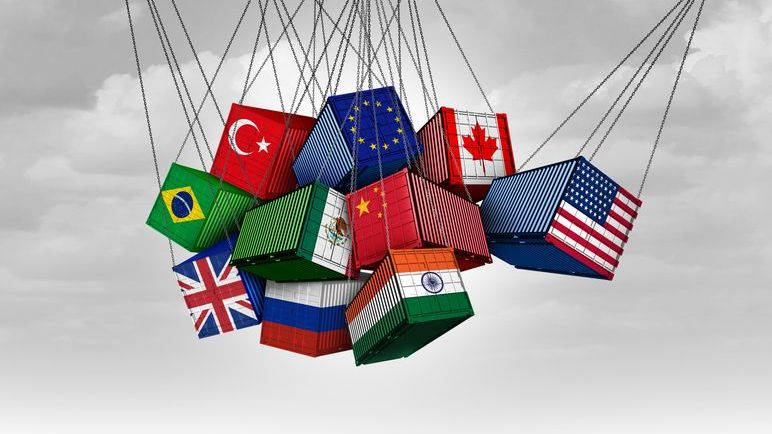President Donald Trump is forging ahead in his second term with an ambitious and controversial plan to remake global trade through tariffs. This raises an important question for consumers: what to buy before the full effects of these tariffs take effect? Consumers may consider purchasing imported cars, electronics or household items now before the full impact of the tariffs are realized. Tariffs of this scope can also affect supply chains, which may lead to delays or reduced availability for certain categories.
It may be time to revisit your financial plan or start working on creating one. That’s where a financial advisor can help. Connect with an advisor today.
What Are the Trump Tariffs?
In his second term, Trump has implemented a series of controversial tariffs aimed at reshaping U.S. trade relationships and bolstering domestic industries. These additional costs levied on imported goods represent a significant shift towards protectionist trade policies.
The Trump administration has rolled out a massive package of tariffs, including a 10% tariff on all imports to the United States and higher, country-specific rates for nations running significant trade surpluses with the United States. Additionally, Trump has rolled out a 25% tariff on automobiles made outside the U.S. A 25% tariff on foreign made auto parts is expected to take effect May 3.
The administration’s stated aim is to reduce trade deficits and encourage domestic manufacturing. The imposition of higher tariffs has also prompted retaliatory measures from affected countries, however. The situation has led to a general increase in global trade tensions and uncertainty for businesses, investors and consumers. Many also warn that the tariffs will have an inflationary effect in the U.S., driving up the cost of a host of consumer goods.
10% Tariff on All Imports
On April 5, 2025, all foreign imports became subject to a 10% baseline tariff. This means companies that import goods from foreign countries must pay a 10% tax on those goods to U.S. Customs and Border Protection. However, it’s expected that many companies will pass those extra costs on to the consumer through higher prices.
Tariffs on Canada and Mexico
Effective March 4, 2025, the U.S. imposed a 25% tariff on most imports from Canada and Mexico. The administration justified these tariffs as measures to address issues related to illegal immigration and drug trafficking.
Initially, goods covered under the United States-Mexico-Canada Agreement (USMCA) were exempted until April 2, 2025. In addition, Canadian energy is subject to a lower tariff of 10%.
Tariffs on China
On March 4, 2025, tariffs on Chinese imports were increased from 10% to 20%. This escalation was part of ongoing trade tensions between the two nations, with the U.S. citing unfair trade practices and intellectual property concerns. In announcing a new round of tariffs on April 2, Trump increased the tariff on Chinese goods to 34% as part of a package of reciprocal tariffs.
Reciprocal Tariffs
On April 2, 2025—which Trump called “Liberation Day”—he announced a series of “reciprocal” tariffs on dozens of countries and trading partners. While China was subjected to a 34% tariff, the European Union was slapped with a 20% tariff. Economists have questioned the methodology used to calculate the tariffs, arguing that basing them on trade deficits oversimplified complex economic relationships and could lead to unintended economic consequences.
Global Steel and Aluminum Tariffs
Starting March 12, 2025, a 25% tariff was imposed on all steel and aluminum imports. This action aimed to protect domestic metal industries from foreign competition and address national security concerns related to industrial capacity.
Foreign-Made Vehicles
On March 26, 2025, President Trump announced a 25% tariff on all imported automobiles, effective April 3, 2025. This measure targets passenger vehicles like sedans, SUVs, crossovers, minivans and light trucks.
The administration asserts that these tariffs will encourage domestic automobile production and generate substantial tax revenue. However, industry analysts predict that these tariffs could lead to increased vehicle prices for consumers and significant impacts on automakers with global supply chains.
The Anderson Economic Group, a private consulting and economic analysis firm, estimates that these tariffs could increase vehicle prices by $2,500 to $20,000. The first-year impact on consumers is forecast to be $30 billion.
Analysts expect manufacturers to adjust production lines, cease certain trim and equipment offerings and reconsider importing low-volume models. While sellers will absorb some costs initially, consumers will eventually bear nearly all the burden of higher tariffs.
Buyers may begin seeing price increases on popular models within a month, according to Anderson. Vehicles with large inventories might experience delays of two months or more before price adjustments occur.
What Should Consumers Do When Tariffs Take Effect?

The implementation of tariffs on imports is anticipated to lead to price increases on various goods, including automobiles, steel and wood products. Consumers can consider several strategies to manage these changes effectively.
Advance Purchases
For significant expenditures like automobiles, purchasing before tariffs are enforced may result in cost savings. It’s unclear how and when these tariffs may be passed on to consumers, but some consumers are expediting their buying decisions to avoid these potential increases.
Explore Alternatives
Substituting purchases of imported goods with domestic products or alternative brands can mitigate the impact of tariffs. For instance, considering vehicles manufactured in the U.S. may help avoid the additional costs associated with imported cars.
Window stickers on new cars contain relevant information about the vehicle’s country of origin. However, even domestic manufacturers might experience price increases due to higher costs of imported components.
Review Your Budget
Given the potential for price increases, assessing and adjusting personal budgets to accommodate higher costs is advisable. With tariffs potentially adding significant costs to household expenses, revisiting financial plans can help manage the impact effectively.
Delay Non-Urgent Projects
Postponing non-essential projects that require materials like steel or wood may also be beneficial. For example, tariffs on these materials can lead to higher costs for construction and renovation projects. Delaying such endeavors until market conditions stabilize could result in cost savings.
Stay Informed
Keeping abreast of trade developments and understanding how they affect consumer prices is useful in an uncertain tariff environment. Being informed enables proactive decision-making and better financial planning in response to evolving economic conditions.
What Should Investors Do When Tariffs Take Effect?
The implementation of tariffs under President Donald Trump’s administration has introduced significant volatility into financial markets. Many investors have been prompted to reassess their strategies. In particular, understanding which sectors may be adversely affected and which could potentially benefit from tariffs can inform investment decisions.
Sectors Potentially Adversely Affected
The 25% tariff on imported automobiles and parts is likely to increase production costs for manufacturers reliant on foreign components. This can potentially lead to higher vehicle prices and reduced sales. As a result, investors should monitor auto-related and other companies with substantial exposure to international supply chains.
Tariffs on steel, aluminum, and other materials can elevate costs for manufacturers, impacting profit margins. Companies in sectors such as electronics, appliances, and construction materials may face challenges due to increased input costs.
Sectors That May Benefit
While increased tariffs are anticipated to pose challenges to many industries, U.S.-based producers of some products might experience increased demand. Imports of iron and steel, for instance, are targeted for higher tariffs. Investors could explore opportunities in companies that extract and process these materials domestically.
Some industries could benefit from indirect effects of tariff hikes. For instance, economic uncertainty and inflation concerns have historically driven investors toward safe-haven assets like gold. Recent surges in gold prices suggest a continued trend in this direction.
Investment Strategies
Maintaining a diversified portfolio across various asset classes and geographies can help mitigate many kinds of risks, including those associated with trade tensions. Exposure to service sectors less directly impacted by tariffs, such as technology or healthcare, may provide balance.
Investment fundamentals can play a role in risk management in this environment. Investing in companies with strong balance sheets, low debt levels and consistent earnings can offer resilience amid market volatility. Sectors like software, cybersecurity and defense technology, which have lower foreign revenue exposure, may be less affected by tariffs.
Uncertainty surrounds the current tariff situation. As a result, staying informed with up-to-date knowledge of international responses to U.S. trade policies is essential. Retaliatory measures from other countries could influence global supply chains and market dynamics, impacting investment portfolios.
Bottom Line

Tariffs will likely drive up prices on various goods, including automobiles, electronics and household items. Consumers may consider purchasing imported products before the effects of these tariffs are fully realized. Exploring domestically produced alternatives can also be a viable strategy to mitigate the impact of these trade measures. Staying informed about ongoing trade developments and adjusting purchasing decisions accordingly can help individuals manage the financial implications associated with these tariffs.
Tips for Dealing With Inflation
- Economists and financial experts expect the Trump tariffs to increase inflation. You may want to consider investing in Treasury Inflation-Protected Securities (TIPS), I Bonds and certain types of real assets like commodities or real estate can help preserve purchasing power over time. These options adjust with inflation and may offer a hedge against rising prices.
- A financial advisor can help you account for inflation in your financial plan. Finding a financial advisor doesn’t have to be hard. SmartAsset’s free tool matches you with vetted financial advisors who serve your area, and you can have a free introductory call with your advisor matches to decide which one you feel is right for you. If you’re ready to find an advisor who can help you achieve your financial goals, get started now.
Photo credit: ©iStock.com/wildpixel, ©iStock.com/andreswd, ©iStock.com/wildpixel
